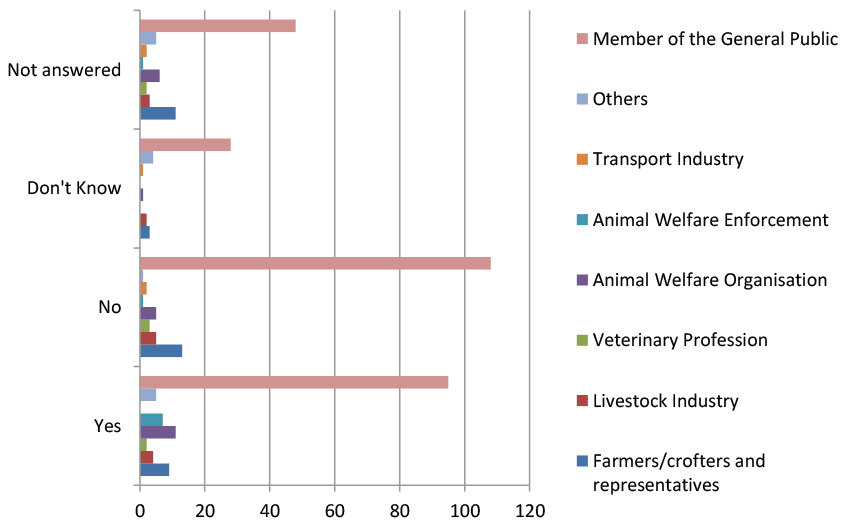Welfare of animals during transport - consultation: summary report
Analysis of the responses received to the full public consultation, between 4 December 2020 to 26 February 2021, of the Farm Animal Welfare Committee's opinion on the welfare of animals during transport.
Question 11
Do you agree with the Scottish Government’s position on mid-journey breaks and proposed course of action? Please provide any further relevant information.
It is the view of the Scottish Government that mid-journey breaks for animals during long journeys may be a key component of providing for high welfare during transport, and should be considered alongside maximum journey times. In principle we agree that, in line with better regulation principles, the maximum journey times and rest periods relating to drivers and to animals being transported should be as coherent, mutually consistent and aligned as possible. We wish to explore further how far and in what way these time periods could be aligned, and we agree that further evidence gathering and research could usefully inform these considerations.

Of the 310 responses to this question, 42.9% were in favour of the Scottish Government’s position on mid-journey breaks and proposed course of action. 44.5% were not in favour and 12.6% did not express a view.
Those supporting the Scottish Government’s position on further exploration also considered that “alignment of drivers hours ... would benefit both the drivers and the stock” (Argyll and Bute Council and other enforcement agencies); and that “mid-journey breaks are a key component of providing high welfare during transport” (Dogs Trust).
Whilst there was support for alignment, information was provided that “many longer journeys involve two drivers” so it might not always be practicable “tying transport times explicitly to the rules” applying to a single driver (Scottish Pig Producers).
A number of respondents considered that the need for a proper definition of “rest periods is critical” (Quality Meat Scotland) and that there could be merit in investigating whether “time spent at auction market should be counted as neutral time and as a mid-journey rest period” (Institute of Auctioneers and Appraisers in Scotland).
A small number of welfare organisations, and their supporters, agreed with FAWC that “time spent on board should not be considered as rest” (Humane Society International UK and OneKind).
While mid-journey rest breaks garnered support, a number of considerations were addressed by respondents. These included comments that “mixing animals and increasing the risk of disease spread” (NFUS Shetland) could occur; “repeated loading and unloading” could increase stress levels (OneKind); and the potential to “increase biodiversity risk” (British Veterinary Association).
A number of comments also considered the length of rest periods with the Scottish Animal Welfare Commission noting that “unloading and loading are physical risk periods” and “should not happen if the rest period is not meaningful to the animal”. Scotland’s Rural College also noted that 45 minute rests seem inadequate as there is “evidence that animals need several hours to be able to eat and drink sufficiently”.
A couple of unnamed organisations supporting further research suggested that “equines be rested for a minimum of 9 hours off the vehicles” in between two periods of 12 hours travel.
Some respondents, especially those from Orkney, considered that the “rest periods referred to do not seem unreasonable” for road transport. However, they considered there would be “practical implications to animal transport” if this was to refer to “sea times” (Orkney Branch of the Pony Club).
A high proportion of those who did not support the Scottish Government’s position used their responses to reiterate their opposition to live animal exports. In addition, a number of those from island communities also mentioned additional costs to small producers.
There were relatively few mentions of the effect of the proposals for breeding animals. Compassion in World Farming, and its individual supporters, considered that for the “smaller number of longer trips for breeding animals, this is a practical proposal”. This, however, appeared to be contingent on an 8 hour maximum journey for other purposes.
Contact
There is a problem
Thanks for your feedback